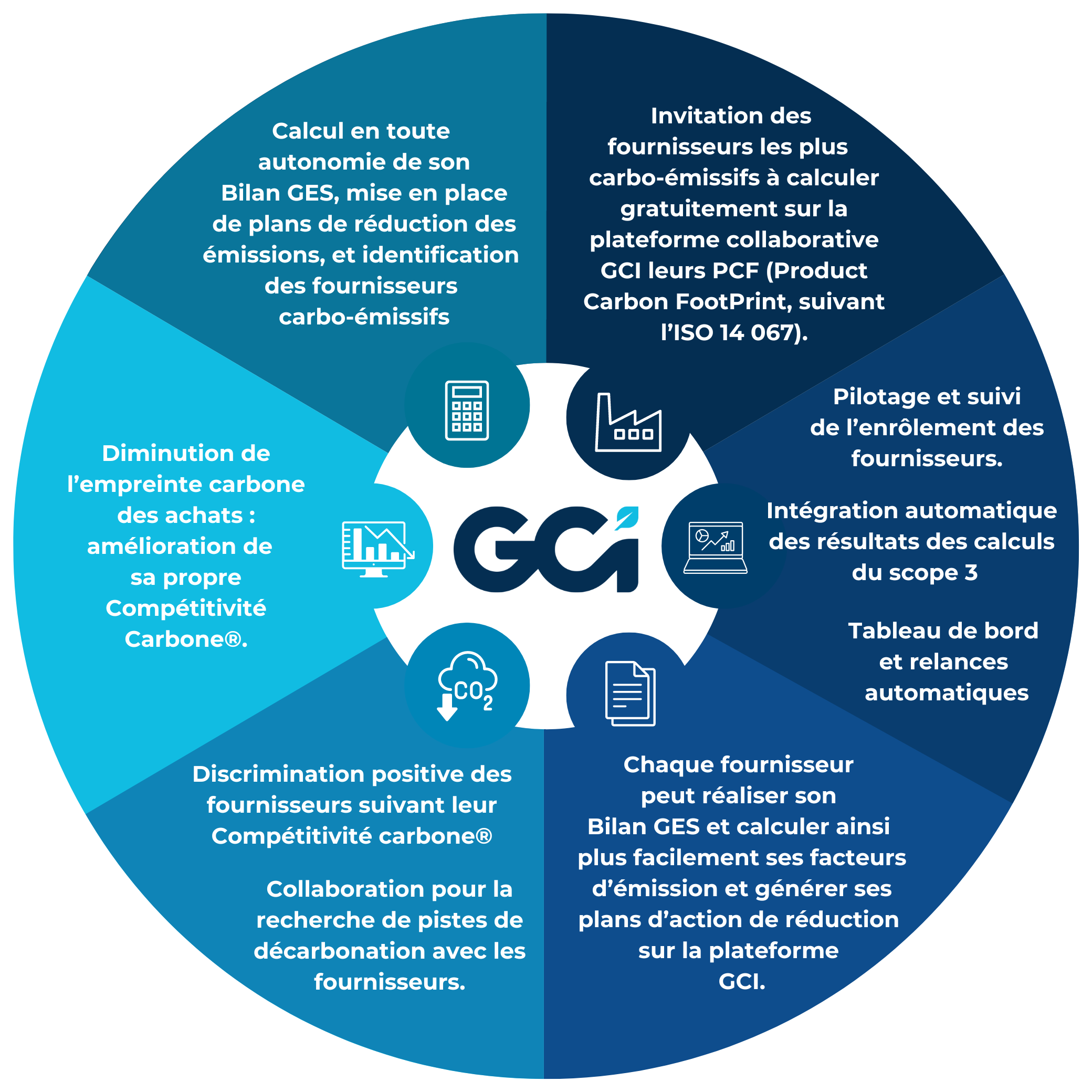Why and how can we improve our GHG balance sheet thanks to the commitment of our suppliers?

Faced with increasingly strict and rigorous regulatory requirements regarding environmental issues, and the need to reduce their future Carbon Tax Base®, it is imperative for companies to commit to a process of decarbonization of their activities.
There is an essential lever for achieving this low-carbon trajectory: the involvement of suppliers, who account for 50 to 90% of Scope 3 emissions; it is therefore necessary to first identify the most carbon-intensive suppliers and then implement a reduction action plan with them.
We will see below why and how to define a purchasing policy with positive discrimination "Carbon"®, with the aim of enhancing the Carbon Competitiveness® of its suppliers and thus improving its own.
1. the carbon footprint of a company depends strongly on its ecosystem
1.1 Scope 3: why is it important?
1.2 Limitations of emission factors
1.3 How to engage your suppliers
1.4 Calculating a Composite® emission factor
2. The benefits generated by the decarbonization of its purchases
2.1 Improving its Carbon Competitiveness
The carbon footprint of an organization is highly dependent on its ecosystem
The carbon footprint of a company is defined by the measurement of the greenhouse gas emissions it generates and is highly dependent on those of its suppliers, which is less well known.
In fact, the decarbonization of purchasing represents the greatest potential for reducing GHG emissions for companies. Incorporating the "carbon weight" criterion into the evaluation and referencing of suppliers is a decision that everyone will have made in the years to come, as this criterion has become that of their own customers!
"The upstream carbon of one is always the downstream carbon of the other
The "carbon weight" is the amount of greenhouse gases (GHGs) emitted during the entire life cycle of a product, i.e. from the production of its raw materials to its final use and disposal.
The importance of the carbon weight of purchases is steadily increasing with the tertiarization of the economy and the increase in imports of manufactured goods with a high carbon content, such as electronics or automobiles.
The imperative of decarbonized responsible purchasing must therefore be increasingly emphasized in the strategy of companies. It will allow to significantly decarbonize the activity and thus lower the carbon weight of a company, improve its Carbon Competitiveness® and, very soon, the associated taxes.
🎯 Scope 3: why is it important?
Accounting for the 3 regulatory scopes is mandatory for a complete GHG balance sheet.
🌿 Scope 1: includes direct emissions
🌿🌿 Scope 2: includes indirect energy-related emissions
🌿🌿🌿Scope 3: includes all other significant indirect emissions that arise from the operations of the legal entity as well as, where applicable, from the use of the goods it produces
Thus, scope 3 is the perimeter that encompasses the majority of a company's emissions.
Scope 3 corresponds to indirect emissions such as :
For a company:
- The extraction of materials purchased by the company for the realization of the product,
- Purchased products,
- Upstream and downstream transportation of goods,
- Those related to the transportation of employees and customers coming to buy the product,
- Those related to the use of the goods sold
- etc.
For a community :
- Purchased goods (public purchases),
- Waste management in the territory
- etc.
The GHG inventory® of companies and local authorities is therefore made up of 50 to 80% of Scope 3 emissions. The acquisition of materials, products and services thus represents the area with the greatest reduction potential.
⚠️ It is therefore important to account for GHGs under the three scopes 1, 2, 3, because if we only look at direct emissions, we get a limited view of the climate responsibility of an entity.
This is where emissions factors come in. The method used to assess an organization's carbon footprint is simple: multiply the organization's activity data to a set of corresponding emission factors that convert them into tons of CO2 equivalent.
❌ Limitations of emission factors
The emission factors provided by the reference databases (Base Carbone®, Defra, (GB), EcoInvent) are often evaluated from average data and do not allow to value the best suppliers, those with the lowest carbon weight.
They therefore make the company's BEGES (Bilan Carbone) less accurate, and don't allow it to use a qualitative Carbon criterion to choose its suppliers, thus depriving it of the greatest potential for reducing its emissions.
It is therefore essential to be able to take into account the actual emission factor of each of its providers, along the value chain, rather than just the average emission factors of the baselines.
Reminder of what an emission factor is:
An emission factor (EF) is the coefficient relating the GHG emission to the data of activities generating these emissions. There are 4 of them:
1️⃣ Monetary EFs (in kgCO2e/€ spent): They are proposed by ADEME in France, or EcoInvent in Switzerland for example, and are applicable to scope 3 emissions. They considerably simplify the work of entering the GHG balance.
🔴 Negatives:
- Has little confidentiality of accounting data: the company must disclose accounting information to make its balance sheet GES
- FE not very significant: its emissions depend on the prices at which one has negotiated its electricity, its purchased goods...
- ADEME gives an uncertainty of 80% for these EFs
2️⃣ EFs by type of product or service: They are proposed by ADEME in France (Base Carbone® or Base Impacts®) and EcoInvent in Switzerland for example. These are average factors: a good (e.g. a T-shirt) can be produced in Asia or Europe using different processes, which can distort the real carbon footprint of the product.
🔴 Negatives:
- Not all goods are covered by these PAs.
- These PAs remain approximations that do not differentiate between providers.
3️⃣ The composite EF (Product Carbon Footprint - PCF): They are developed from the detailed composition and allow to take into account the GHG emissions associated with each stage of the life cycle of a product (extraction and transport of raw materials, manufacturing processes, distribution from the factory, use and end of life of the product).
➡️ Obtaining these EFs requires the involvement of its suppliers.
4️⃣ EFs per Unit of Work (UWW): They are evaluated from the carbon footprint of an organization by allocating its GHG emissions to its production units. They allow to take into account the different stages of the life cycle in a precise way.
🤝 How to engage your suppliers with GCI
Today, any purchaser, public or private, has the right to impose the presentation of their GHG assessment to their suppliers. But it is much more interesting to know the emission factor of the products and services offered by its suppliers, their "Carbon Weight" allowing to engage a "positive carbon discrimination", essential to improve its Carbon Competitiveness®.
Thus, to commit each of them to provide their "Carbon Weight", the company has on the GCI platform:
- A "propagation" module: automatic information to each of its service providers of this request for information on their GHG emissions, associated with the recommendation of the GCI service to ensure compliance and simplified reporting of calculations.
- A "carbon" analysis tool for bids, enabling it to give preference to those who will be able to present a better carbon "weight" associated with their supplies or services.
By requesting their own emission factors, companies or local authorities can calculate the real carbon footprint of their goods or services, by eliminating the need to use default values, which are generally higher.
This collaborative management of the environmental performance of service providers and clients over time, facilitated by GCI, makes the concept of Sustainable Purchasing real and concrete.
It allows to accompany the supplier according to the requirements and recommendations:
- Standards from the ISO 14 040 series of standards specific to Life Cycle Assessment
- ISO 14 067 concerning the carbon footprint of goods and the sectoral benchmarks of ADEME's Impacts® database
This advice also helps guide the supplier, who is familiar with the different processes and materials used to produce his goods or services, so that he can correctly break down the GHGs of his activity into the work units for which he wishes to evaluate the EF to be given to his customers.
The different EFs per unit of work (expressed by weight, volume, area, euro, man/day...) that can be evaluated are the following:
- EF / production units (consumer goods produced)
- FE / service
GCI enables the enrolment of its carbon-emitting suppliers, which is essential for the continuous improvement of its own Carbon Competitiveness®.
The virtuous circle of buyers and suppliers.
" My Carbon Competitiveness® depends on that of my suppliers, and conditions that of my customers.

✅ Calculate a Composite® emission factor
Accurate measurement of composite EFs requires the involvement of its providers. Thus, it will be easier to convince them by pointing them to the GCI platform where they can :
- Either make free evaluations of their compliant composite FE®, in a simple, didactic, transparent and auditable way, and therefore opposable to third parties.
- Either make their own complete GHG assessment, simplifying their calculation even in large numbers of their EFs, and offering them reduction action plans, at a very competitive price (enabled by the 100% digitization of the process) while benefiting from the support of GCI experts.
In some cases, a PCF's request to their vendor may not be appropriate because they are unwilling or unable to evaluate a PCF/work unit via GCI for various reasons.
In this case, the GCI platform offers the customer an interface for "Calculating a PCF or a composite emission factor" from different databases:
- The EMPREINTE® Database: Generic database of official inventory for the French governmental program of environmental display of consumer products. (Processes, energy, raw materials...)
- The UK BEIS (DEFRA) database: UK Department for Business, Energy and Industrial Strategy database
Thanks to the different "primary" emission factors "primary" emission factors available in the above-mentioned databases, everyone can evaluate the product's emission factors with respect to the processes and materials used in its design.
Thus, in case of failure of its supplier, the company can carry out this composite emission factor evaluation itself, if it knows the composition and the manufacturing and delivery process of the purchased product.
Example: You need to integrate the carbon weight associated with a range of imported t-shirts for which you know precisely the different components (raw materials, processes, place of production, transport...). You can create its composite EF from the emission factors of the Base Empreinte®, Base Ecoinvent® and Base UK BEIS which allow you to associate the carbon weight of the following information:
- Recycled cotton yarn/kg
- New cashmere yarn/kg
- Dyeing on yarn/kg
- Washout/kg
- Coating/m² of textile
- KWh electricity by process (according to country of production)
- Transport
Conclusion: From the different processes and raw materials that allow the manufacturing of a product, it is possible to evaluate quite precisely the global carbon impact associated with its production.
GCI then allows this carbon impact to be used in the form of a composite EF in order to make it more accurate in the GHG report and the associated reduction action plan.
In order to be effective,decarbonization of purchasing requires that the precise emissions of suppliers be taken into account and that this criterion be implemented as an essential complement to the classic quality/price ratio.
The benefits of decarbonizing purchases
Apart from its environmental impact, decarbonization of purchasing also brings a lot of value to organizations that start this process. Whether it is at the competitive, regulatory, or business level, there are only benefits.
🥇 Improving Carbon Competitiveness®.
Carbon Competitiveness ® is the ability to demonstrate, with the same quality of production of service or product, a lower GHG emission than its competitors.
This recent concept is a direct consequence of customers' new demands to decarbonize their purchasing. Everyone has become concerned with reducing their own carbon footprint, both in terms ofnew fiscal and regulatory constraints, and in commercial terms, and this Carbon Competitiveness®has also imposed itself on them, particularly in calls for tender.
This is a new component of every company's strategy.
On the other hand, ignoring it means taking the risk of seeing your competitors stand out on this subject, which has become an additional market selection criterion.
It is up to each company to find the balance between reducing greenhouse gas emissions, which is a commercial advantage, and the economic imperatives of traditional competitiveness, including the selling price.
The objective is therefore for the company to display emission factors for its products and services that are lower than those of its competitors, which are also calculated with rigor and compliance.
➡️ ISO 14 067 precisely defines the calculation methods and the control of the results for the calculation of these factors called PCF (Product Carbon Footprint).
The large share of purchasing in these calculations offers a great opportunity to engage with one's own suppliers in a new type of collaboration:
💪The Carbon Competitiveness® of companies depends on those of its suppliers, conditions that of their customers, and generates benefits for all :
- This is a virtuous dynamic that allows for a lasting relationship of shared progress between the parties.
- The promise of accelerating a solid low-carbon trajectory, because it involves all stakeholders, is beneficial for everyone, and is essential for our common fight against climate change.
💯 Competitive advantages
Initiating a decarbonization process increases the chances of meeting the new requirements of calls for tenders. Indeed, more and more governments and organizations are including sustainability, decarbonization and environmental criteria in their calls for tender. Companies that can meet these criteria have a better chance of winning these tenders and gaining a competitive advantage.
📃 Compliance with the regulations
The Grenelle II law of July 12, 2010 requires companies with over 500 employees (250 for overseas departments) to carry out their GHG inventory®at least every 4 years, and local authorities with over 50,000 inhabitants at least every 3 years.
Decree 2022-982 reinforces and broadens this obligation, as Scope 3 becomes mandatory, as well as the publication of a transition report attesting to the company's low-carbon pathway.
It is therefore in the interest of companies to involve their service providers, who are responsible for most of their Scope 3, so that they indicate their "carbon" performance and choose them in relation to their "Carbon" performance.
In this way, a company can be aware of the environmental and societal consequences of the resources it uses, and change them if it feels they are not being sourced sustainably.
💰 Tax advantages
The future implementation ofcarbon quotasdecided in July 2021 for transport (rapid application for maritime, then road transport) and real estate, the announced end of free quotas, and the arrival in 2025 of theCarbon Import Tax voted by Europe leads to a new requirement of precise calculations and opposable to third parties, and proven emission reductions.
Indeed, the future Carbon Tax Base®will be reduced; it could represent large sums of money for those who have not already committed to reducing their GHG emissions, the basis for these new taxes.
💬 Client testimony from Samuel Réthoré
As an expert in Purchasing & CSR engineering and Director of missions at the Purchasing Academy, Samuel Réthoré shares with us why it is imperative to integrate CSR issues into a company's global strategy:

"Decarbonization of industrial, commercial and tertiary activities is now an imperative and priority goal as demonstrated by heightened regulatory expectations."
Therefore, to anticipate regulatory requirements, organizations need to implement a low-carbon strategy now. Samuel Réthoré explains how the GCI platform is the ideal tool for defining and communicating a low-carbon trajectory:
"Theuser-friendliness of GCI's software solution will allow for quick and easy communication of periodic decarbonization metrics to drive short-, medium- and long-term performance."







